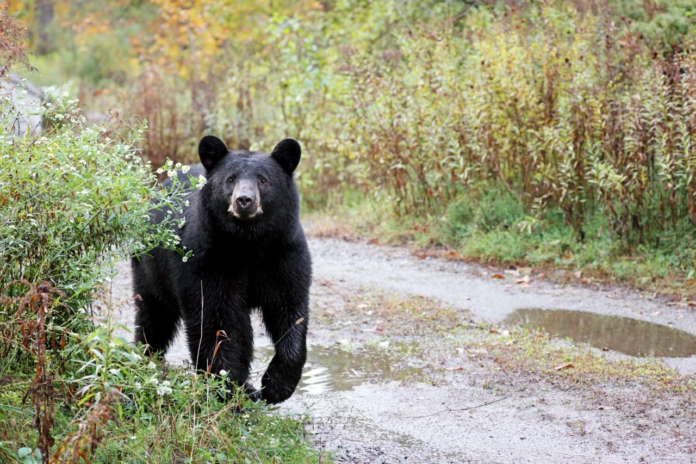TOPEKA (KSNT) – Black bears are not something you’d expect to see in the Sunflower State, but recent sightings suggest the animals may be becoming more common in some areas.
27 News reached out to Matt Peek, wildlife and research biologist with the Kansas Department of Wildlife and Parks (KDWP), to get an expert’s viewpoint on black bear activity in the state. Overall, he said bear sightings, while still rare, aren’t as unusual as they might have once been.
Confirmed black bear sightings in Kansas
Peek told 27 News in a written response there have been 10 confirmed sightings of black bears since 2015. Unlike other big predator sightings, like mountain lions which might be mistaken for other wildlife, black bears “are often pretty visible and detectable,” with several bears being documented multiple times while in Kansas.
“Prior to about 2000, bears occurred very rarely in Kansas,” Peek said.
“Since that time, we’ve had annual black bear visits to southwest KS pretty consistently. Apparently, these bears find their way back to established range in other states by the fall. Beginning in about 2015, we started getting nearly annual visits in southeast Kansas, which mirrored the increase in bears that has taken place near Kansas in Missouri and Oklahoma.”
Black bears are typically seen in two areas in Kansas: the southeast and southwest corners of the state. Both of these areas are in close proximity to established black bear populations in nearby states.
The Kansas Mammal Atlas with Fort Hays State University (FHSU) indicates that black bears seen in the Sunflower State are usually juveniles coming from nearby Missouri, Arkansas, Colorado and Oklahoma. Most sightings occur in the summer as these young black bears leave their home ranges and look for food and places to live.
“We’re not aware of any resident bears living year-round in the state at this time,” Peek said. “Almost all of our confirmed bears have been yearlings and documented May-July when this age class separates from their mom and disperses from their natal home range. Confirmations outside of these 3 months have been very rare, and no cubs have been documented in modern times.”
Sightings and other reports of black bears in Kansas kept by FHSU are usually confirmed by Peek through the use of game cameras with video footage and photos. In some cases, these sightings may be of the same bear moving through the area seen multiple times by different people. The current list of sightings and associated observations for black bears in Kansas, most being recorded after 2000, includes the following:
Bourbon – 1
Chautauqua – 1
Cherokee – 5
Crawford – 7
Doniphan – 3
Douglas – 1
Greeley – 1
Hamilton – 1
Labette – 2
Mitchell 1
Morton – 3
Saline – 1
Stevens – 1
Black bears spotted in Kansas do not stick around and there is currently no new evidence to suggest a wild population is established in the state. The most recent sightings occurred in 2021, according to FHSU.
Should people be worried?
Peek said there have been no reports of bad encounters with black bears in Kansas in modern times. Bears, including grizzlies, were once common in Kansas’ eastern areas but were driven out by the late 1800s. However, the KDWP does keep resources online to help people who are concerned about black bears near them.
“People should not be worried about encountering a black bear in Kansas,” Peek said. “They’re still uncommon and primarily limited to the southern corners of the state.”
Peek recommends people check out the website BearWise which partners with the KDWP for more information on coexisting with black bears. The information listed on this website was created by biologists and gives tips for living near black bears, how to avoid bear encounters and what to do if you see one.
“People usually have to make some adjustments to live with black bears because they are so attracted to food sources,” Peek said. “Bird feeders, bee hives, chicken coops, stored grains, BBQ grills, and unsecured trash are some of the things that attract bears and usually require people to change what they do to get along with bears. A small percentage of people who would rather kill the bear than make the adjustments necessary to live with it can probably significantly slow or even prevent them from becoming established in the state.”
Large predators, such as bears, mountain lions and gray wolves, cannot be killed without reason in Kansas, according to the KDWP. Landowners can destroy wildlife, including black bears, found in or near buildings on their premises or when they are destroying property. However, significant efforts must be made beforehand to alleviate the situation.
How to report black bear sightings
People who think they have evidence of black bear activity in Kansas can make a report to the KDWP by contacting its Emporia Research and Survey Office at 620-342-0658. Evidence can consist of videos, photos or tracks.
If you’ve captured a black bear on camera and want to share it with 27 News, just use this link.



